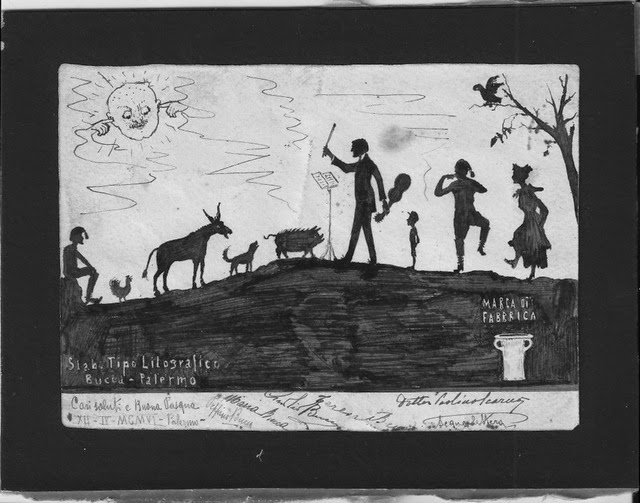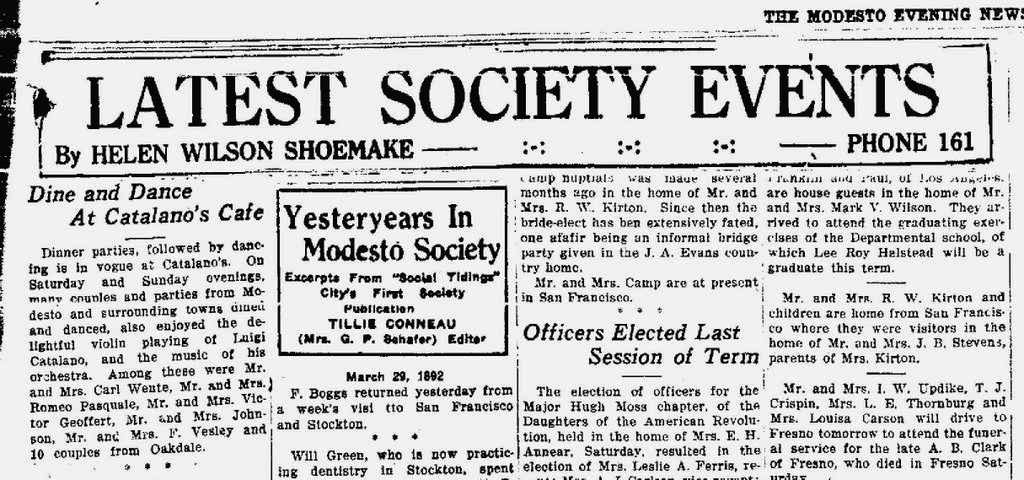Luigi Catalano, the future founder of the Napa Valley Symphony, was born in Lercara Friddi, Sicily, Italy, near Palermo, on November 29, 1881.
He attended the Palermo Conservatory of Music, where he studied violin and conducting. He found employment as the first violin in various orchestras in Italy and France.
 |
| This wonderful portrait of Luigi conducting, was signed in French on January 1, 1905, "From Paris, Best Wishes." |
LUIGI CATALANO: Napa Valley Symphony Founder
VIRTUOSO VIOLINIST, MUSIC EDUCATOR, AND DIRECTOR OF THE NAPA CONSERVATORY OF MUSIC IN THE 1930s
Luigi Catalano in Paris, 1905
Happy Easter 1906, Palermo: Luigi and His Violin Conducting the Locals
Luigi Catalano Arrives at Ellis Island, New York City, September 1906
Violist Paolina Civiletti (Catalano) and Violinist Nelina Civiletti (Schiro), circa 1903
 |
Paolina Civiletti (later Catalano), 1903
|
The House in Pacific Heights where Luigi, Paolina and Nelina Played for Wealthy Music Lovers
Luigi Catalano, Director of the Strand Theater Orchestra, Modesto CA, 1921
At the beginning of 1921, Luigi and his family moved to Modesto, California from San Francisco so that Luigi could take up his new position as the Director and Conductor of the Strand Motion Picture Theatre Orchestra.
According to Wikipedia, "From the beginning, music was recognized as essential, contributing to the atmosphere and giving the audience vital emotional cues. Once full feature films became commonplace, however, music was compiled from "photoplay music" by the pianist, organist, orchestra conductor or the movie studio itself, which included a cue sheet with the film. These sheets were often lengthy, with detailed notes about effects and moods to watch for. Starting with the mostly original score composed by Joseph Carl Breil for D.W. Griffith's groundbreaking epic The Birth of a Nation (USA, 1915) it became relatively common for the biggest-budgeted films to arrive at the exhibiting theater with original, specially composed scores.
By the height of the silent era, movies were the single largest source of employment for instrumental musicians (at least in America)."
 |
Catalano Family Homes in San Francisco
A Musical Gift from Luigi's Former Music Professor
Vespertina, A Medieval Song for Violin and Piano, by Rosario Profeta
of Palermo, Sicily, Italy
Illustration by F. Cutino
The printed dedication reads (in French): To Mademoiselle Altes Lycresy,
In the days of happiness...
 |
| Add caption |
The handwritten inscription reads: To My Dear Luigi Catalano, whose artisitic merit is equaled by his integrity- [From] His old teacher, R. Profeta. It is dated the 22nd of August, 1928.
Vera and Gloria Catalano, Luigi and Paolina's Musical Daughters
Mr. Catalano, Music Teacher, Napa High School
Luigi Catalano and Napa High School Student Orchestra, with Daughter Gloria and Her Cello, 1936
Luigi's Legacy: Mentoring Music Students in Napa During the Depression
Luigi was extremely generous to his music students in Napa during the Depression with reduced fees and even free lessons if they couldn't afford to pay. Luigi also mentored his students in many ways, one of which was making sure they were exposed to the classical music offerings around the Bay Area.
Another musician that the Catalano family heard was the Puerto Rican pianist, Jesus Maria Sanroma, who, according to Wikipedia, "is considered by many to be one of the 20th century's most accomplished and important pianists." Below, is the signed photograph that Vera acquired in 1946:
Luigi Catalano and the Napa Valley Symphony, 1933
Luigi Catalano, sometime in the late 1920s or early '30s  |
| Founder and Conductor Luigi Catalano with the Napa Valley Symphony in the Year of its Founding, 1933 |
The Napa Valley Symphony was founded in 1933 by Luigi Catalano, who was also the director of the Napa Conservatory of Music, as a means for students and volunteer musicians to provide symphonic music to the community. Following a brief period of dormancy during World War II, it was reformed as a community orchestra and prospered as such through the years. In 1981, thirty-three years after his death, the Napa Valley Symphony became a professional orchestra and continues to play today as Symphony Napa Valley.
Luigi Catalano, Wife Paulina Civiletti and Younger Daughter Gloria
Vera Catalano Simpkins at the Piano with her Husband Bill Simpkins at the Microphone, early 1950s
Inside the cover of the complete opera, music and libretto, of Madame Butterfly is this inscription from Vera to Bill:
(Lt. Pinkerton is the leading male role in the opera and the lover of Madame Butterfly)
Subscribe to:
Posts (Atom)








%2B-%2BMozilla%2BFirefox%2B962014%2B70445%2BPM.bmp.jpg)






































